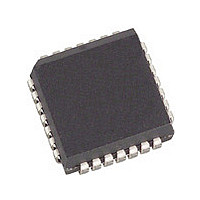CY7B923-JI Cypress Semiconductor Corp, CY7B923-JI Datasheet - Page 13

CY7B923-JI
Manufacturer Part Number
CY7B923-JI
Description
Manufacturer
Cypress Semiconductor Corp
Datasheet
1.CY7B923-JI.pdf
(33 pages)
Specifications of CY7B923-JI
Lead Free Status / RoHS Status
Not Compliant
Available stocks
Company
Part Number
Manufacturer
Quantity
Price
Company:
Part Number:
CY7B923-JI
Manufacturer:
CY
Quantity:
5 530
Company:
Part Number:
CY7B923-JI
Manufacturer:
CYPRESS
Quantity:
1 053
Part Number:
CY7B923-JI
Manufacturer:
CYPRESS/赛普拉斯
Quantity:
20 000
Document #: 38-02017 Rev. *E
The framer function in Bypass mode is identical to Encoded
mode, so a K28.5 pattern can still be used to reframe the serial
bit stream.
Parallel Output Function
The 10 outputs (Q
neously, and are aligned with RDY and CKR with timing allow-
ances to interface directly with either an asynchronous FIFO
or a clocked FIFO. Typical FIFO connections are shown in
Figure 4.
Data outputs can be clocked into the system using either the
rising or falling edge of CKR, or the rising or falling edge of
RDY. If CKR is used, RDY can be used as an enable for the
receiving logic. A LOW pulse on RDY shows that new data has
been received and is ready to be delivered. The signal on RDY
is a 60%-LOW duty cycle byte-rate pulse train suitable for the
write pulse in asynchronous FIFOs such as the CY7C42X, or
the enable write input on Clocked FIFOs such as the
CY7C44X. HIGH on RDY shows that the received data
appearing at the outputs is the null character (normally
inserted by the transmitter as a pad between data inputs) and
should be ignored.
When the Transmitter is disabled it will continuously send pad
characters (K28.5). To assure that the receive FIFO will not be
overfilled with these dummy bytes, the RDY pulse output is
inhibited during fill strings. Data at the Q
the correct received data, but will not appear to change, since
a string of K28.5s all are decoded as Q
SC/D = 1 (C5.0). When new data appears (not K28.5), the
RDY output will resume normal function. The “last” K28.5 will
be accompanied by a normal RDY pulse.
Fill characters are defined as any K28.5 followed by another
K28.5. All fill characters will not cause RDY to pulse. Any
K28.5 followed by any other character (including violation or
illegal characters) will be interpreted as usable data and will
cause RDY to pulse.
As noted above, RDY can also be used as an indication of
correct framing of received data. While the Receiver is
awaiting receipt of a K28.5 with RF HIGH, the RDY outputs will
be inhibited. When RDY resumes, the received data will be
properly framed and will be decoded correctly. In Bypass mode
with RF HIGH, RDY will pulse once for each K28.5 received.
For more information on the RDY pin, consult the “HOTLink
CY7B933 RDY Pin Description” application note.
Code rule violations and reception errors will be indicated as
follows:
0–7
, SC/D, and RVS) all transition simulta-
0–7
7–0
outputs will reflect
=000 00101 and
Receiver Serial Data Requirements
The CY7B933 HOTLink Receiver serial input capability
conforms to the requirements of the Fibre Channel specifi-
cation. The serial data input is tracked by an internal PLL that
is used to recover the clock phase and to extract the data from
the serial bit stream. Jitter tolerance characteristics (including
both PLL and logic component requirements) are shown
below:
1. Good Data code received
2. Good Special Character
3. K28.7 immediately following
4. K28.7 immediately following
5. Unassigned code received
6. -K28.5+ received when
7. +K28.5– received when
8. Good code received
• Deterministic Jitter Tolerance (Dj) > 40% of t
• Random Jitter Tolerance (Rj) > 90% of t
• Total Jitter Tolerance > 90% of t
• PLL-Acquisition Time < 500-bit times from worst-case
with good running disparity (RD) 0
code received with good RD
K28.1 (ESCON Connect_SOF) 0
K28.5 (ESCON Passive_SOF)
RD was +
RD was –
with wrong RD
measured while receiving data carried by a
bandwidth-limited channel (e.g., a coaxial transmission line)
while maintaining a Bit Error Rate (BER) < 10–12.
measured while receiving data carried by a
random-noise-limited channel (e.g., a fiber-optic trans-
mission system with low light levels) while maintaining a Bit
Error Rate (BER) < 10–12.
phase or frequency change in the serial input data stream,
to receiving data within BER objective of 10–12. Stable
power supplies within specifications, stable REFCLK input
frequency and normal data framing protocols are assumed.
Note: Acquisition time is measured from worst-case phase
or frequency change to zero phase and frequency error. As
a result of the receiver’s wide jitter tolerance, valid data will
appear at the receiver’s outputs a few byte times after a
worst-case phase change.
RVS SC/D Qouts Name
B
. Total of Dj + Rj.
0
0
1
1
1
1
0
1
1
1
1
1
1
1
B
. Typically
CY7B923
CY7B933
00-0BC0.0-11.0
00-FFD0.0-31.7
Page 13 of 33
E0
E1
E2
E4
27
47
B
. Typically
C7.1
C7.2
C0.7
C1.7
C2.7
C4.7
















